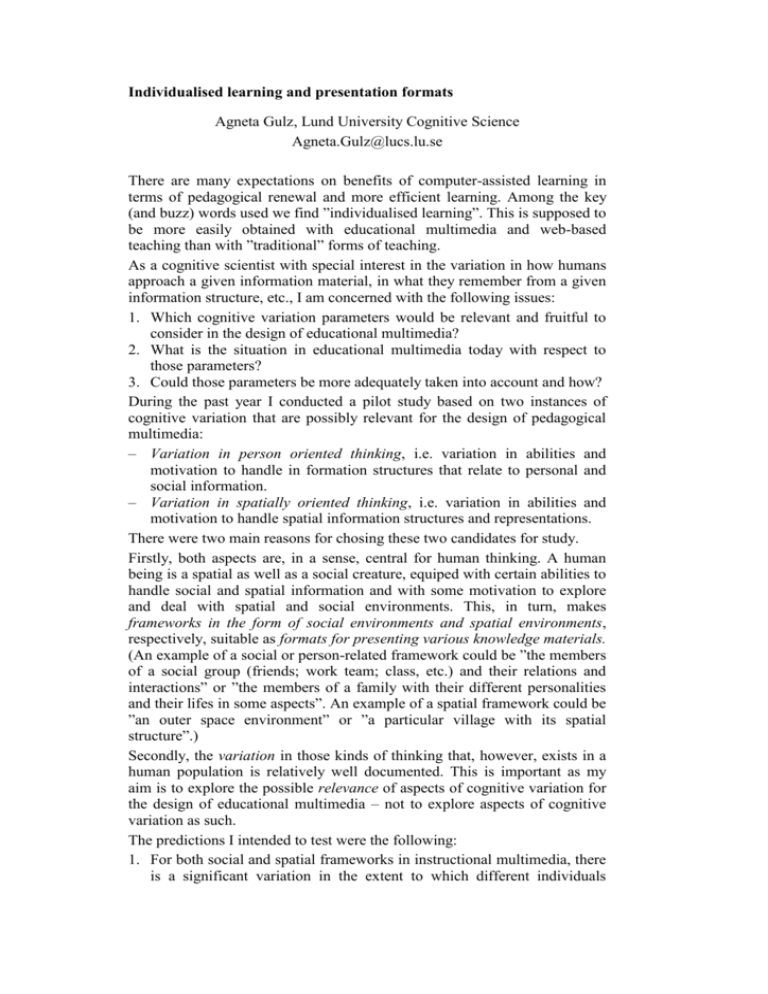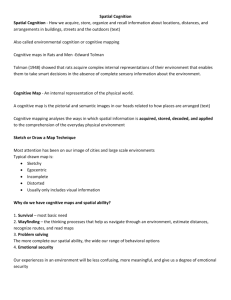Word
advertisement

Individualised learning and presentation formats Agneta Gulz, Lund University Cognitive Science Agneta.Gulz@lucs.lu.se There are many expectations on benefits of computer-assisted learning in terms of pedagogical renewal and more efficient learning. Among the key (and buzz) words used we find ”individualised learning”. This is supposed to be more easily obtained with educational multimedia and web-based teaching than with ”traditional” forms of teaching. As a cognitive scientist with special interest in the variation in how humans approach a given information material, in what they remember from a given information structure, etc., I am concerned with the following issues: 1. Which cognitive variation parameters would be relevant and fruitful to consider in the design of educational multimedia? 2. What is the situation in educational multimedia today with respect to those parameters? 3. Could those parameters be more adequately taken into account and how? During the past year I conducted a pilot study based on two instances of cognitive variation that are possibly relevant for the design of pedagogical multimedia: – Variation in person oriented thinking, i.e. variation in abilities and motivation to handle in formation structures that relate to personal and social information. – Variation in spatially oriented thinking, i.e. variation in abilities and motivation to handle spatial information structures and representations. There were two main reasons for chosing these two candidates for study. Firstly, both aspects are, in a sense, central for human thinking. A human being is a spatial as well as a social creature, equiped with certain abilities to handle social and spatial information and with some motivation to explore and deal with spatial and social environments. This, in turn, makes frameworks in the form of social environments and spatial environments, respectively, suitable as formats for presenting various knowledge materials. (An example of a social or person-related framework could be ”the members of a social group (friends; work team; class, etc.) and their relations and interactions” or ”the members of a family with their different personalities and their lifes in some aspects”. An example of a spatial framework could be ”an outer space environment” or ”a particular village with its spatial structure”.) Secondly, the variation in those kinds of thinking that, however, exists in a human population is relatively well documented. This is important as my aim is to explore the possible relevance of aspects of cognitive variation for the design of educational multimedia – not to explore aspects of cognitive variation as such. The predictions I intended to test were the following: 1. For both social and spatial frameworks in instructional multimedia, there is a significant variation in the extent to which different individuals spontaneously use the frameworks as a support for association and memory. 2. For both social and spatial frameworks in instructional multimedia, there is a significant variation in how interested different individuals are in those frameworks or worlds and in their inclination to explore them.1 On another level I predict that the variation in how individuals approach the two kinds of presentational formats is primarily due to cognitive factors (rather than social class, degree of education, etc.) In the pilot study two different user interfaces to the same program were presented to 24 participants, 12 women and 12 men2. The two interfaces employ, respectively, a spatial and a person-related format for organizing the information and presenting the functions of the program3. The outcome of the pilot study was that about a third of the participants seemed positive towards the person related format (and clearly prefered this to the spatial framework). Examples of statements: ”The information is most accessible in the one using people.” ”It’s more personal and alive [...] A more pleasant way to present information.” ”... I have been in too many games where you walk from room to room, often without a real reason to explore really. A social context is more stimulating to explore, I think.” Another large third of the participants were most positive towards the spatial framework, saying for example: ”I used to draw maps like these when I was little and have always enjoyed to explore such worlds.” ”When the task is to learn where different things are it is much easier for me to think spatially.” ”The map and the park suits my way of thinking.” The main objective of the pilot study was to get a preliminary assessment of the general hypothesis about variation in approaches to spatial and person related frameworks. Given the positive outcome, I am currently working on the design of more targeted studies to adress the two predictions mentioned above. In these, tests of short term and long term retention complemented with qualitative interviews will be used to assess the ease of association and memory, and short and long term observational studies combined with interviews will be used to estimate individuals motivation to explore programs. If the individualizing potentials of computer assisted learning is to be realized, the overall research task of identifying relevant aspects of cognitive variation for the design of computer assisted learning will be central 4,5. 1It should be pointed out, however, that the two kinds of framework are not opposites. There is no competitive relation between them for an individual. One and the same individual can be highly interested – or very little interested – in exploring both kinds of environments. One and the same individual might be equally good – or not so good – at handling both kinds of knowledge structures. 2A corresponding pilot study with school children is being conducted. 3The interfaces were designed to be as equivalent as possible in terms of complexity, style, realism and gender neutrality. 4This remains even if it would turn out that the hypotheses about varying approaches to spatial and social frameworks are misguided. Specifically, work on the presentation, or in other words the user interfaces, of programs is important, since it is the user interface of a multimedia or web product that defines the experience of it and limits its use6. Presentational formats in the sense intended in this paper can constitute contexts designed to support exploration, association and understanding of new knowledge materials. If an adequate variety of such presentational formats is well represented, the usability of instructional multimedia can be enhanced. 5There are also other important aspects regarding individualization: The possibility for individuals to work at their own pace is generally supported in computer assisted learning, and in some cases there is a possibility to chose between levels of difficulty. 6Cf. Mårdsjö, 1990.







